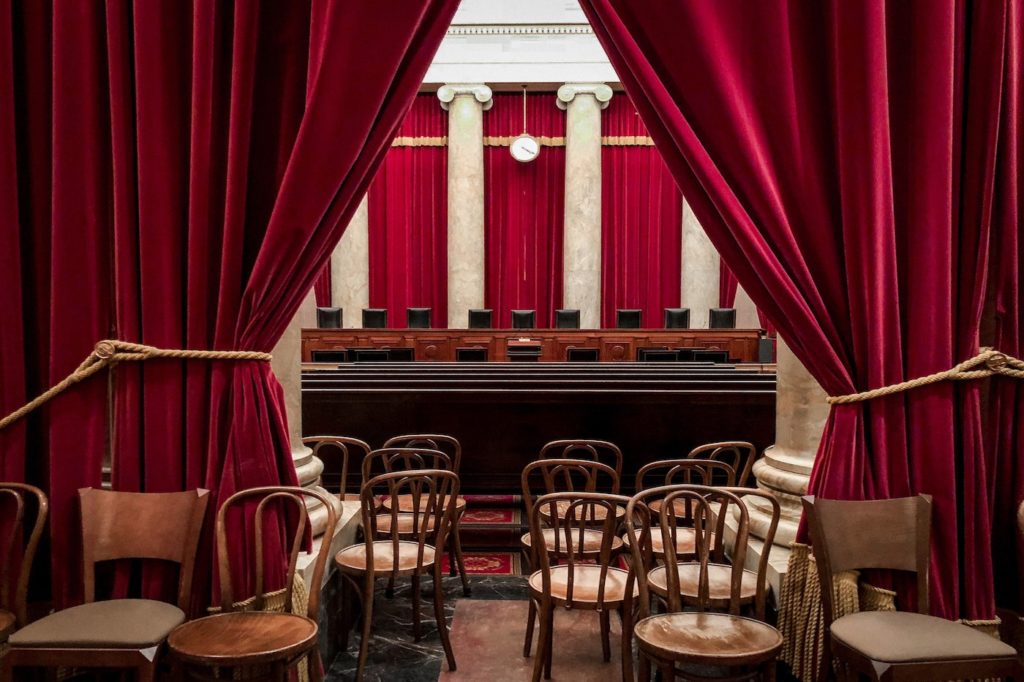In June, the Supreme Court decided Fulton v. City of Philadelphia, unanimously striking down the city’s decision that it would no longer refer children to Catholic Social Services, or enter a full foster care contract with it in the future, because the agency refused to certify same-sex couples as adoptive parents. But the unanimity did not disguise the most significant underlying issue in the case: three justices would have overruled Employment Division of Oregon v. Smith (1990), and two justices who joined the Court’s narrower opinion (not overruling Smith) suggested there were strong arguments to overrule it, though it wasn’t necessary to do so in this case. That could sound like an imminent death knell for Smith.
The Smith opinion was written by Justice Antonin Scalia, the greatest twentieth-century Supreme Court originalist—maybe the “re-founder” of originalism on the Court. It is surprising, and perhaps ominous, that the newly “conservative” Court in 2021 should target one of the few decisions in which he was able to return the Court’s jurisprudence to a more traditional, or originalist, form.
The Smith decision followed the jurisprudence of the first hundred years of American judicial history, a time when the term “originalism” was unknown, because it wasn’t, at that point, an “ism”—it was simply to do the judge’s job of interpreting the Constitution. In Free Exercise jurisprudence, Smith returned to the “secular regulation rule” exemplified by Reynolds v. U.S. (1878), that religious minorities have no automatic constitutional exemption from ordinary secular laws to which they object.
The founders were certainly aware that secular laws sometimes burdened the practice of religion; they were all familiar with the Quakers’ refusal of military service, for example. While the founders disagreed on how to deal with the issue, most believed it was within the discretion of the legislature—a matter of “legislative grace”—whether to grant exemptions from such laws. (See Vincent Phillip Muñoz and Philip Hamburger’s work on that issue.) There is little or no support (despite the attempts of fine scholars like Michael McConnell) for the proposition that the Free Exercise clause required judicially mandating exemptions from secular laws.
Start your day with Public Discourse
Sign up and get our daily essays sent straight to your inbox.Why not? Because “originalism,” as a theory of constitutional interpretation, entails a certain theory of judicial power, which is well stated in Federalist No. 78: judicial review is an interpretive act—of judgment rather than will.
It is surprising, and perhaps ominous, that the newly “conservative” Court in 2021 should target one of the few decisions in which Justice Scalia was able to return the Court’s jurisprudence to a more traditional, or originalist, form.
The Sherbert Test: Turning Judges into Legislators
Should judges decide when religious believers have a right to exemption from secular laws? From 1963 to 1990, the Supreme Court said yes. Beginning with Sherbert v. Verner, the Court employed a modern “compelling state interest” test, under which judges weighed the importance of an asserted state interest against any free exercise claim to an exemption.
It is easy to understand why this test was attractive. Sometime secular laws, however legitimate, just don’t seem that important, especially if they have serious consequences for religious believers. A classic example was the flag salute cases of the 1940s: flag salutes are certainly legitimate and useful, but why should Jehovah’s Witnesses (who think saluting the flag is “worshiping a graven idol”) be compelled to do them?
Why had earlier judges in America not employed such a “balancing” test? Because they thought such a task was not judicial. It required the judges to weigh the importance of an asserted state interest, but where was the judge to find legal guidance to do that? The Constitution doesn’t say anything about such matters. Weighing state interests is a flat-out policy judgment, and that is a legislative task. Scalia gave considerable weight to precedent, but he was very clear about why a judge should reject the Sherbert test: it made him something other than a judge: a legislator. Legislatures have the power to provide exemptions from laws, but judges do not.
Scalia was certainly aware of some of Smith’s potential unpleasant consequences. He faced the issue forthrightly:
It may fairly be said that leaving accommodation to the political process will place at a relative disadvantage those religious practices that are not widely engaged in; but that unavoidable consequence of democratic government must be preferred to a system in which each conscience is a law unto itself or in which judges weigh the social importance of all laws against the centrality of all religious beliefs.
That religious believers might not receive as much protection as they had under Sherbert was not something that Scalia sought. It was simply an inevitable consequence of judges’ confining themselves to doing what they ought to do: to say what the law is, rather than to make it.
Why had earlier judges in America not employed a “balancing” test? Because they thought such a task was not judicial.
The Inadequate Originalism of Alito’s Fulton Opinion
Justice Alito (writing also for Justices Thomas and Gorsuch) in Fulton contends that the proper application of originalist principles clearly requires overruling Smith. I think they clearly require upholding Smith.
Alito begins, rightly, with the constitutional text: “We should begin by considering the ‘normal and ordinary’ meaning of the text of the Free Exercise Clause: ‘Congress shall make no law . . . prohibiting the free exercise [of religion].’” He maintains that, taking the normal and ordinary meanings of “prohibit” and “free exercise,” “the ordinary meaning of ‘prohibiting the free exercise of religion’ was (and still is) forbidding or hindering unrestrained religious practices or worship.”
That is an absurd reading of the text. If it were true, the normal and ordinary meaning of free exercise would protect human sacrifice, which is, for some people, a religious practice. This is precisely the kind of result that originalist rules of legal interpretation going back to Blackstone would rule out. Alito makes no effort to show how unrestrained religious practices could possibly be the normal and ordinary textual meaning of free exercise.
The text of the Free Exercise Clause must mean something other than that there is a right against any restraint on religious practices. The only plausible meaning is that it prohibits acts that directly, rather than incidentally, impinge on religious practices. Human sacrifice can obviously be punished, consistent with a respect for free exercise, because murder laws don’t target religious practice—that is, the nature and purpose of such laws is not to prohibit the free exercise of religion; they only have the side effect of limiting it for some people. Alito calls this a “a hair-splitting interpretation,” but in fact it is the only interpretation that makes sense of the text itself.
The text of the Free Exercise Clause must mean something other than that there is a right against any restraint on religious practices. The only plausible meaning is that it prohibits acts that directly, rather than incidentally, impinge on religious practices.
A “Special Meaning” of the Text?
Alito’s interpretation, by contrast, is indeed “hair-splitting.” It is flat-out indefensible, until he smuggles into the text historical qualifications of the free exercise right.
His main response to the textual argument is to drag out the proverbial “parade of horribles”: if Scalia’s interpretation is adopted, then all kinds of awful things can happen. But that proves nothing. The Constitution doesn’t prohibit every bad thing, and the assumption that the Constitution must authorize judicial prohibition of every bad thing is the source of much of the modern jurisprudence that contemporary originalism rightly rejects.
Alito tries to avoid this problem by saying that “we cannot disregard the possibility that some of the terms in the Free Exercise Clause had a special meaning that was well understood at the time.” So, he asks, “What was the free-exercise right understood to mean when the Bill of Rights was ratified?” Looking at historical scholarship (especially McConnell’s), he finds “one predominant model” that “extends broad protection for religious liberty but expressly provides that the right does not protect conduct that would endanger ‘the public peace’ or ‘safety.’”
In place of the normal and ordinary meaning of the words of the Free Exercise Clause, Alito has substituted a “special meaning,” derived from historical sources. The Free Exercise Clause doesn’t, after all, prohibit “forbidding or hindering unrestrained religious practices or worship,” as he had argued earlier; it means that you can forbid or restrain certain religious practices, as long as they fit into a special category known from historical research. That is a kind of originalism—but it is not textualist originalism, which is the originalism of the Constitution.
I have no objection to the proposition that the Free Exercise Clause did not protect religious acts that endangered the public peace or safety. Of course it doesn’t—because laws protecting public peace and safety do not directly target the free exercise of religion; they affect it only incidentally. But there is no textual ground for judges to uphold government acts that incidentally affect religious practices only in cases where the latter endanger public peace or safety.
Misreading the History of Religious Exemptions
Alito goes on to argue that the claim that “the free-exercise right included the right to certain religious exemptions is strongly supported by the practice of the Colonies and States.” But most of the history he cites involves exemptions provided explicitly by state laws or constitutions. These prove nothing about a judicial power to mandate exemptions based on the federal Free Exercise Clause.
Alito recognizes Scalia’s response to this argument (in Boerne): the historical examples of exemptions “show only what the Constitution permits, not what it requires.” He responds: “But legislatures provided those accommodations before the concept of judicial review took hold, and their actions are therefore strong evidence of the founding era’s understanding of the free-exercise right.”
But even ignoring for the moment the fact that the concept of judicial review “took hold” right from the beginning (see Federalist no. 78, and many of the state ratifying conventions, especially of New York, Pennsylvania, and Virginia), if it took hold later, what would that prove? That legislatures provided exemptions doesn’t imply that judges had the authority to mandate them.
And if judicial review hadn’t “taken hold” earlier, why would that have been? Because people doubted the extent of judicial power? Yes—and that shows the founders would never have embraced a broad judicial power to mandate exemptions from laws that incidentally affected religious practice.
The large margins by which the Religious Freedom Restoration Act (intended to overrule Smith) was passed suggest that Smith is widely unpopular. But that doesn’t make it wrong.
The Morality of True Originalism
Justice Alito’s “originalist” case against the Smith rule doesn’t hold water. One might wish that the Free Exercise Clause, as originally understood, had provided a basis for more judicial protection of religious rights than it does. But wishing doesn’t make it so.
Some originalists—especially those who are engaged in judging, litigating, and politics—understandably feel internal “pressures” to find a “satisfactory” originalist reading, especially when it involves something as important as religious liberty. Judges in particular find it hard when the original meaning of the document is widely unpopular, or even outside the “Overton window,” that is, the bounds of realistic discussion today. The large margins by which the Religious Freedom Restoration Act (intended to overrule Smith) was passed suggest that Smith is widely unpopular. But that doesn’t make it wrong.
Conservatives see that, if in the past small and unusual religious minorities were most likely to have their free exercise curtailed by secular regulations (Jehovah’s Witnesses, the Amish, Seventh Day Adventists), in the contemporary world conservative Christians, Jews, and Muslims who oppose absolute laws against non-discrimination (regarding gender, homosexuality, and now transgenderism) will more likely have their free exercise curtailed. In some cases (as the Supreme Court suggested in Masterpiece Cakeshop), the attack on religious freedom will be quite deliberate, motivated by deep animus against religious views and practices. But (as Grutter v. Bollinger showed, in the case of affirmative action), lawyers are very good at lying, and can help legislative bodies craft regulations in ways that avoid obviously targeting religion.
A return to Sherbert would provide a useful tool to protect conservative religious groups. But I think Scalia had it right: judges don’t have the authority to interpret the Constitution to get better policy results, even if those are really, really important results.
In fact, I would phrase this idea in a way that Scalia was generally loath to do: the judge is bound by certain moral requirements, including the requirement to act within his legitimate jurisdiction. This is the moral ground for originalism, and it explains why conservative judges should uphold Smith, despite its unpleasant consequences. Conservatives have to do the difficult work of democratic politics, fighting it out in the political process—even in a time when the deck is stacked against them.














